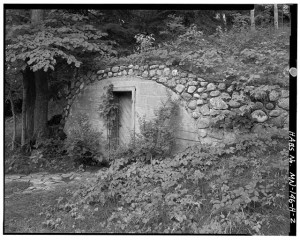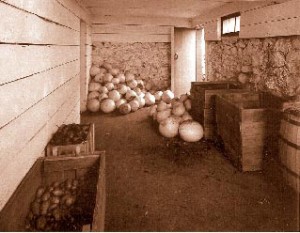How to Create a Root Cellar for Food Storage
THE IDEAL ROOT CELLAR
The produce is still alive – stored carbohydrates of energy is consumed in the presence of oxygen and produces heat and carbon dioxide. To maintain the proper “living” conditions, at least three variables need to be considered: temperature, humidity and ventilation.
Temperature:
Most cold tolerant or cool season crops will store best between 33 and 35F or just above freezing and up to 40F. Warm season crops sensitive to chilling injury (tomatoes, cucumbers, etc) are typically stored at temperatures above 50F unless processing, cooking or eating will occur shortly after removal from storage. The temperature needs to be actively monitored and managed and will vary with the quantity of produce in the space.
Humidity:
Most root and leafy crops will store best at high humidity (+80%) or moisture levels. Root crops like carrots need to be stored in some moist medium to maintain quality. Some crops like onion, garlic and winter squash store better at low humidity level (less than 60%). Moisture may need to be added by wetting the floor or walls with water depending on the construction methods.
Ventilation:
Reasons for ventilation include: 1) removal of heat of respiration, 2) replenishing the oxygen supply, 3) removing volatile compounds from the produce that may effect flavor or sprouting like ethylene. The greater the density or amount of produce in the space, the more ventilation is needed. Ventilation or air tubes need to be planned prior to construction and place during construction.
Common storage categories are 1) cold dry, 2) cold moist, 3) cool dry, 4) cool moist. (source)
| Vegetables | Temp F. | % Humidity | Storage Time | Comments |
| Beets | 32° | 90–95 | 3 months | Leave 1-inch stem. |
| Brussels sprouts | 32° | 90–95 | 4 weeks | Wrap to avoid drying |
| Cabbage | 38° | 90–95 | 4 months | Late maturing varieties ** |
| Carrots | 32° | 90–95 | 5 months | Top leaving ¼-inch stem * |
| Cauliflower | 32° | 85–90 | 3 weeks | Wrap in leaves * |
| Celery | 32° | 90–95 | 4 months | Dig with roots *** |
| Chinese cabbage 32° | 90–95 | 2 months | Dig with roots *** | |
| Cucumbers | 50° | 85–90 | 3 weeks | Waxed or moist packing * |
| Kohlrabi | 38° | 90–95 | 3 months | Trim leaves * |
| Onions | 32° | 55–60 | 8 months | Dry for two weeks. |
| Parsnip | 32° | 90–95 | 6 months | Top leaving ¼-inch stem * |
| Potatoes | 38° | 85–90 | 8 months | Pack in boxes unwashed. |
| Squash | 60° | 55–60 | 3 months | Winter types, leave 2-inch stem |
| Tomatoes | 60° | 55–60 | 8 weeks | Single layer in covered boxes |
| Turnips | 38° | 90–95 | 3 months | Waxed or moist packing * |
| Small fruits | 32° | 85–90 | 7 days |
ORGANIZATION OF YOUR ROOT CELLAR
- winter squash
- onions
- potatoes
- garlic
Resources
The following resources provide specific information on how to create and maintain your own root cellar:
The Old Farmer’s Almanac
Mother Earth News
Michigan State University
Root Cellaring by Mike and Nancy Bubel
Modern Homesteaders
Daisy Luther is a freelance writer and editor. Her website, The Organic Prepper, offers information on healthy prepping, including premium nutritional choices, general wellness and non-tech solutions. You can follow Daisy on Facebook and Twitter, and you can email her at daisy@theorganicprepper.ca



We had hundreds of pounds of vegetables and apples we stored each year, and the apples would have made everything else ripen too fast.
If you must store them in the same location try this – Wrap each apple with paper, newsprint or otherwise and store between layers of cardboard in the boxes. If you do not put your potatoes in a bin of dirt or sawdust then at least throw a heavy packing blanket over them in their bags.
Onions, Garlic, squashes all need pantry treatment. Cool – not as cold as root cellar although it can be, but DEFINITELY not as moist. Cellar cool/cold moist – Pantry cool dry.
One year I washed ALL of our squash dipped in mild bleach water and let them air dry all over the kitchen. I also examined for bruising or frost burns and ate those first. Any that had lost a stem got wax poured over the area to seal. They lasted well into spring.
And oh yah, why don’t we still have the homestead? The proverbial SHTF. And it was TEOTWA I knew it.
But I am going to make another attempt here in my older years. If the world still exists in a recognizable form I hope to be on my sons twenty acres in a couple of years…
But before I move I need/want two things. A huge cistern that can be kept from freezing and ? You guessed it – A root cellar!
HalfKin
We ate our last two carrots from last years crop in July this year. Good enough to be grated for salad. We packed them in pails of sand in our root cellar.
We are considering wind mill to draw water up from the deep well if all goes down,but they have parts that wear out also.
I lived three years with no electricity and I didn’t really miss it that much. Those were the days before internet and all.
Thanks for your input,
HalfKin
I will be moving to the family home where I was raised. It is located in central Minnesota and is at the edge of a river. We just put in a new well and a geothermal heat system, so I suppose the grid will fry and the geo won’t be worth squat. However, we do plan to install a hand pump, alongside the geo pump in the well. I found a site that makes them this way so that you do not have to pull your pump from the line in order to switch to hand pumping.
However, it would be nice to also have a windmill for this purpose also. Can anyone suggest a reputable, fair priced place to buy one? The geo killed us $$$$$$. The house has hot water base board heat that also will work, if there is fuel oil to be had at an affordable price and if there is electricity. In addition, the is a fireplace with a heatilator in the living room. It also has an electric fan system to circulate air around the heatilator and then into the room. I do plan to buy a cast iron stove for in the kitchen, as I think that if TSHTF it will be impossible to get cooking gas for very long.
If we get the right tools and build an ice house we could store ice from the river to use in the summer. My father used to talk about their ice house, cutting ice chunks from the pond across the road, and hauling the ice to the ice house and covering it with sawdust. The neighbor makes kitchen cabinets so I think we could stock up on saw dust. Also found a place giving away large plastic type bags that contained 2,000 lbs. Niger thistle seed. We got about 50 of them so I think we do some serious saw dust storage…..LOL
The area is full of the older burr oaks so there is endless wood that can be cut and piled. We are currently in the process of putting an entirely new roof on a huge “shop” and also a two stall garage. I think we will store cut and chopped wood in the shop, and perhaps also some sawdust.
My concern is that TSHTF before we get everything set up.
Any info. Re. Windmills would be greatly appreciated.
We plan to have lots of chickens, goats, and some pigs too.
We also have 28 small sized dogs that we adopted due to the dogs having medical problems, so having everything set up and ready to go is HUGELY important to us.
Thanks for any info and names of resource places……..